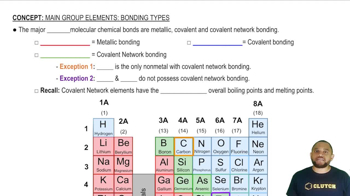Here are the essential concepts you must grasp in order to answer the question correctly.
Electron-Dot Structures
Electron-dot structures, or Lewis structures, represent the valence electrons of atoms within a molecule. They illustrate how atoms are bonded together and show lone pairs of electrons. In the case of aspirin, completing the electron-dot structure involves identifying the bonding pairs and lone pairs around each atom, which is crucial for understanding molecular geometry and reactivity.
Recommended video:
Lewis Dot Structures: Ions
Types of Bonds
In chemistry, bonds between atoms can be classified as sigma (σ) and pi (π) bonds. Sigma bonds are formed by the head-on overlap of atomic orbitals and are single bonds, while pi bonds result from the side-to-side overlap of p orbitals and are found in double and triple bonds. Identifying the number of each type of bond in aspirin is essential for understanding its stability and reactivity.
Recommended video:
Hybridization
Hybridization is the concept of mixing atomic orbitals to form new hybrid orbitals that can accommodate bonding. In organic molecules like aspirin, carbon atoms can exhibit different hybridizations (sp, sp², sp³) depending on their bonding environment. Determining the hybridization of each carbon atom helps predict the molecule's geometry and the angles between bonds.
Recommended video:





